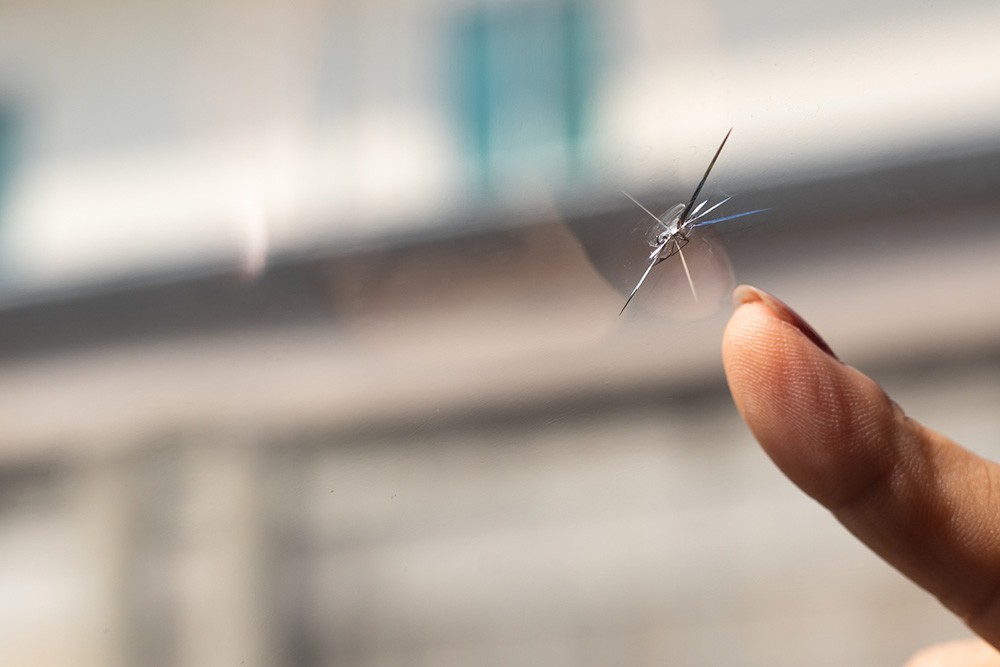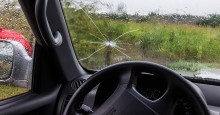
Fix windshield crack while they are still small
Did your windshield get hit by rocks or pebbles when driving on the freeway? Did it get damaged when driving past a road construction crew?
"Windshields should be repaired as soon as possible because temperature fluctuations during fall and winter can spread windshield damage," says Paul Syfko of Glass Medic, a leading producer of windshield repair products. "Once damage spreads out, the windshield becomes less suitable for repair."
Cold autumn and winter temperatures can cause tiny chips and cracks to spread. Take a few moments to examine your windshield for small chips and cracks.
Fix or replace a damaged windshield?
Type, size, depth and location of the damage determine the kind of service required. For example, a nick or small crack in the lower right corner of your windshield can be fixed using a chip repair service.
On the contrary, windshield replacement is generally required when there are multiple cracks, inner layer breakage or extensive damage longer than 30 cenimetres.
Syfko says that repairs generally fall into one or a combination of the following types:
- Bull's eye, a crater type hole surrounded by a dark circle
- Star-series of short cracks
- Crack, a line through the windshield
Repairs can be tricky since damage creates a pocket of air. All of the air must be removed before the resin is applied.
Technicians use a hand or electric pump to create a vacuum. Then, they inject clear resin into the hole and resolve it with an ultraviolet lamp.

Small chips can grow into larger cracks
The best resin matches the glass color and bonds well to prevent the breakage from spreading.
"A typical glass repair process takes 20 or 30 minutes. After repairs are completed, you can drive your vehicle immediately and even take it through the car wash," Syfko said.
Deb Levy, president of the Auto Glass Safety Council opines that if the damaged fracture is in the driver's line of sight—it must be replaced.
The Auto Glass Safety Council is a not-for-profit organization dedicated to the safe repair and replacement of automobile glass.
Levy explains that when it comes to windshield replacement, consumers have two choices. They can opt for Original Equipment Manufacturer (vehicle manufacturer) or aftermarket products.
Here is what to look for when getting a substitute windshield:
- Both OEM and aftermarket windshields must meet safety and quality criteria of the US Department of Transportation.
- Confirmation that replacement windshield meets standard requirements laid down by the vehicle manufacturer.
- Windshield seamlessly integrates with the vehicle's advanced driver-assistance features (automatic braking, lane departure warning, pedestrian detection etc.)
Windshield inspection and repair
According to the National Windshield Repair Division in Conjunction with the Auto Glass Safety Council, autumn is an ideal time to get your windshield inspected by a professional.
The changing weather conditions reveal existing cracks that have gone under the radar in the summer season. Furthermore, additional damage is prevented by addressing these issues before the cold winter months.
NWRD warns against using repair do-it-yourself kits as they only account for 10 percent of breakages, which can compromise the windshield’s integrity and cause irreparable damage.
If complete replacement is required, NWRD suggests using original equipment parts over aftermarket windshields. OEM windshields are designed to meet the safety standards and specifications set by vehicle manufacturers.
OEM products offer the same level of protection in the event of a collision, safeguarding the vehicle’s occupants. Properly fitted windshields minimize wind noise and vibration for a quiet and more comfortable cabin experience.
Vehicle manufacturers also use high-end materials for optical clarity windscreens. This means drivers have a clearer and safer view of the road ahead.
Chipped or cracked Windshield replacement
A windshield is an integral part of your vehicle’s overall safety design. Follow these guidelines for your quality windshield repair:
- Call Your Insurer first: Many insurance companies will waive your deductible if it's not an extensive repair.
- Don't Delay: Fix those chips and cracks as soon you notice them. Remember minor repairs can become expensive replacements.
- Zero Compromise: Avoid using below-par materials that can cause safety concerns like a windshield blowout in an accident.
- Post-Repair Inspection: Ensure technicians have removed your windshield's old molding for a compact fit.
- Best Product: Insist on high-quality adhesive materials and ask for Original Equipment-quality glass only.
- Use a Certified Specialist: Technicians certified by the National Windshield Repair Association meet industry standards for quality work.
Cracks and chips collect contaminants—water, dirt, insects—that can make glass more difficult to repair. The National Windshield Repair Association recommends drivers cover damage immediately with tape to keep the contaminants out until they can get the vehicle to a certified windshield specialist.
For more information about windshield safety, talk to your service advisor about setting up a repair or replacement.
Copyright © 2024 by Sensible Driver. All rights reserved.